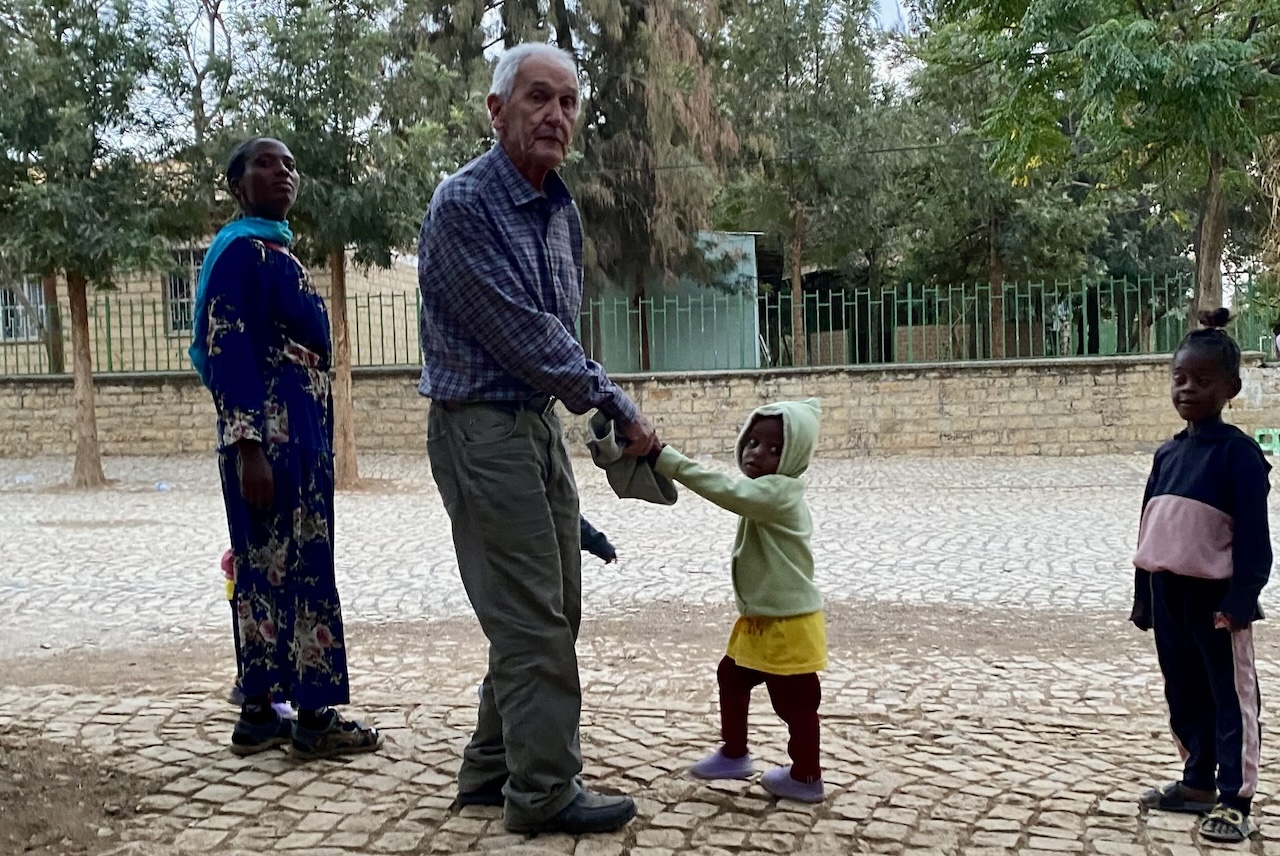Ángel Olaran wishes us a Happy Easter of Resurrection
In this publication, Ángel Olaran wishes us a Happy Easter of Resurrection. The Basque missionary explores the deep connection between nature and spirituality during Holy Week. He explores the Mysteries of Holy Week. From the miraculous phenomena of grafting in plants to the innovative studies of Dr. Masaru Emoto on water. This publication explores how faith transforms reality while highlighting the importance of love and prayer in spiritual life. The Gospels are portrayed as gates to understanding the profound meaning of Jesus’ death and resurrection, highlighting the fundamental role of love and prayer in spiritual growth. Through a reflection on the passion of Jesus and the sacrament of the Eucharist, readers are invited to meditate on the profound unity found in LOVE.
Ángel Olaran: “Happy Easter of Resurrection”
Easter 2024
Small miracles of nature
Grafts
On a plant about 80 cm tall, you open a small tab, into which you insert a small piece, something akin to a pinky fingernail, and that addition will change the nature of the fruit of those roots. Over the years, the already leafy tree will continue to produce fruit according to the nature of the addition – now lost in the tree.
Environment
Dr. Masaru Emoto, “Hidden Messages in Water,” in studies conducted with waters collected from the same source, through laboratory analysis, has observed that, when exposed to the music of different composers, even rhythms, they experience different molecular changes, conditioned by the sonority of the music to which they are exposed. Words like angel and demon offer very opposite molecular results. In his book, he shows a good number of photos of the molecules after exposure.
The water, also from the same source, contained in a glass jar with the word hate or love attached to the jar, obtains very different results: the one exposed to the word love, according to the photos, turns out to be an attractive molecule, and the one from the second jar is repellent.
I don’t know if it is said theologically or devotionally that: the water of baptism is stronger than the blood of the baptized, producing, spiritually, the effect of the graft.
Let what has been said serve as an introduction
Each of the 4 Gospels is like an introduction to the death and resurrection of Jesus: the event of the Humiliated God Man, abandoned, in need of comfort. . .
The Word made flesh, Jesus, communicated more through his deeds than through his voice. Jesus taught a lot verbally during his three years of public life, but the evangelists reduce it to a minimum. Saint John ends his gospel by writing: “There are also many other things that Jesus did; if every one of them were written down, I suppose that even the whole world would not have room for the books that would be written.”
And much of the verbal content of the Gospels is oriented towards our ethical, spiritual life: whoever wants to be first must be last; forgive 70 times 7; I was hungry, and you gave me food; blessed are those who hunger and thirst for righteousness; it is the sick who require a doctor. . .
Little, if any, of his verbal teaching is related to philosophies or theologies. This is how Paul understood it: “I preach only Christ and Christ crucified.”
Many times, verbal teaching is preceded by some carnal work: the commandment of love is preceded by the washing of feet; Jesus announces himself as the water that quenches thirst for eternal life, after asking the Samaritan woman to give him water from the well; he declares himself to be the light of the world after giving sight to a blind man. . . .
In his passion and resurrection, communication is practically through his flesh, incarnation:
In the Mont of Olives, beginning to sweat drops of blood and feeling the anguish of death, he asked the Father, if it were possible, to free him from that moment; to the disciples who were sleeping, he reproached them for not being able to stay awake; he defended his own when the soldiers took him to be condemned. To this are added the 7 words, some of which are already crucified.
The rest of the communication was carnal: he was slapped; the gaze at Peter; the lashes, the crown of thorns; the mockery, carrying the cross, until he was nailed to it and already dead, they still opened his side with a lance.
From the mouth of that crucified, torn flesh comes a cry as if enveloping him, as if emboldening him: I still have strength. And he dies.
And that flesh, which could hardly be called a body, resurrects glorified. And we are with him. Philippians 4:1 Of Jesus already resurrected: “He will transform our human condition according to the model of his glorious condition.”
(I think that the bodies of women raped by groups of men, one after another with the same woman, are in line with the torn body of Jesus.)
The possible objectivity that evil could have, the sark, as opposed to good, Jesus assumed it in his flesh, living it to its last consequences, was abolished with his death and resurrection. The nexus between all this is LOVE.
In the beginning, the Word – the Word – was God. . . The Word, without obligation, became flesh, became Jesus for us, for Humanity, to transform it.
Jesus came to stay
In line with the small miracles of nature,
Isaiah, years before the birth of Jesus, transmitted to us that, just as water and snow, likewise the word that comes out of God does not return to Him without having fulfilled its command.
Analogously, the bread and wine of Jesus’ last supper; the water and blood that flowed from Jesus’ open side, with their exposure to an environment of faith, baptism and the Eucharistic celebration, make us participants in what they signify: the mysterious participation, in the institution of the Eucharist, death and participation in the glorious life of Jesus.
The disciples of Emmaus, during dinner, recognized, in breaking the bread, that the traveler who joined them on the way, was Jesus. Immediately, Jesus disappeared from before them, and they did not need to search for him. They went to communicate it to the others. That dinner for three is a symbol of Jesus’ presence in our Eucharist.
Saint Peter announces that, through baptism water, we are a holy people, a royal priesthood. Temples of the Holy Spirit, according to Saint Paul. The water exposed to the faith of the Church and the words of the celebrant, just as the bread and wine consumed, exposed with the words of the celebrant celebrating the faith of the community, experience that mystical, spiritual change, just like us through them. As Jesus said to more than one person, your faith has saved you; again, our faith is what makes this sacramental miracle possible.
It is our faith that these signs and words, celebrated within the Church, do not return empty to God. We celebrate mystically what Jesus lived physically.
Another meaningful experience for Jesus is that there was no dichotomy between his multiple activities, his deeds, and his intimate prayer life, alone with the Father. Jesus did not fall into activism at the expense of taking away time for contemplation, for intimate encounters with the Father.
For Saint Teresa, the greatest mystical discovery in her life was to enjoy in Jesus, God MAN. From there, she experienced that God loves man so much that the greatest gift we can offer him is to leave him, at that moment of intimate prayer, to help the needy person, making this activity, prayer life, carnal, for intimacy with God, through the needy person. Between solitary prayer and carnal prayer, there is no priority. In both cases, what prevails is LOVE. Without any duality, the two types of prayer are immanent in each other: contemplative prayer necessarily leads to life prayer, and this leads to contemplative prayer.
The mutual love that spouses offer each other in the giving of their bodies is the nexus of their being ONE and not two.
Saint Teresa, at the beginning of her mystical life, experienced that the active apostolate life took time away from act, contemplative prayer, which was what nourished, vivified the person.
From there, she came to believe that the spiritual life, both in act prayer and in work prayer, life, depends on love in each activity. One prayer leads to another.
According to Saint Teresa, the praying person has to mature in their experience of God, coming to feel that there is nothing on earth but God and him/her—and from Him, conquer the world.
HAPPY EASTER OF RESURRECTION
Ángel
With the collaboration of










